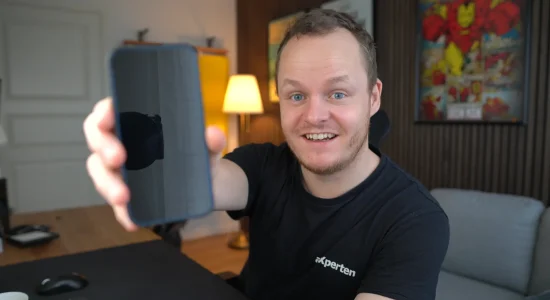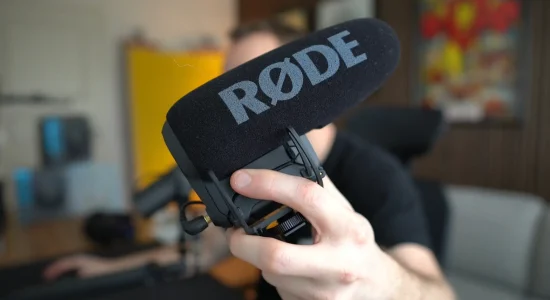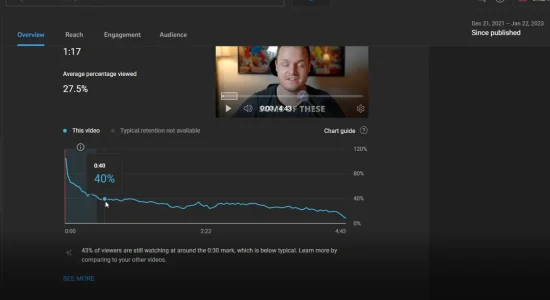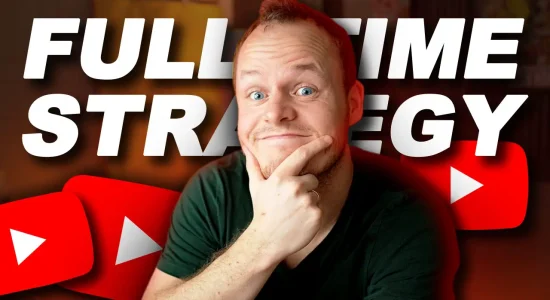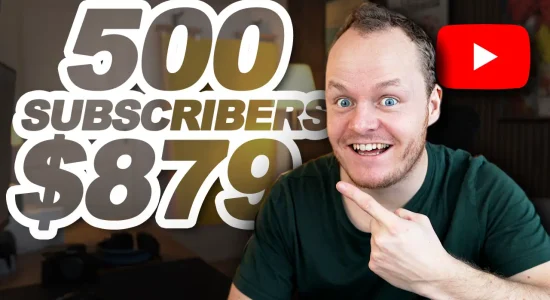Only approximately 4% of all YouTube channels have more than 10,000 subscribers, and many aspiring YouTubers quit and let their channels die before they ever reach even 1,000 subscribers. With these rather sad figures, you might wonder why so many people fail to create a successful YouTube channel?
Here are seven reasons why YouTube channels die:
- The YouTube channel isn’t making any money.
- YouTubers fail to create entertaining or helpful content.
- Creators post too few videos or upload inconsistently.
- Creators burn themselves out and give up too early.
- The YouTube channel doesn’t have a clear strategy.
- YouTube creators don’t have or learn video editing skills.
- There isn’t enough promotion on the YouTube channel.
YouTube is a fantastic platform when used correctly and has a reach that few platforms can equal. However, countless creators never made the cut on this popular platform.
Let’s take a closer look at these reasons and discuss how to prevent your YouTube channel from meeting the same unfortunate fate as many others.
1. The YouTube Channel Isn’t Making Any Money
One of the main reasons that YouTube channels die is that the channel isn’t making any money, so creators get discouraged and stop making videos because it isn’t worth the time or effort if it isn’t going to produce revenue.
When they start a YouTube channel, many people dream of it eventually being a source of income for them. However, it is challenging to build a YouTube channel that is successful enough to make money, and it takes a lot of time and work to get to this point.
If creators aren’t willing to wait long enough or work hard enough, they will likely give up and let their channel die before they start making money.
You can measure your earnings on YouTube by Revenue Per Mile, or RPM, which is the earnings for every 1,000 views after YouTube takes their revenue share. This figure reflects multiple revenue sources, including:
- Ads.
- YouTube Premium subscriptions.
- Live streams.
- Channel memberships.
For a YouTube channel to make money, that channel has to have a large and consistent audience, and the only way to build this audience is to upload great content and engage with viewers consistently.
Those new to the platform find it tempting to buy YouTube subscribers to boost their channel, but this is illegal according to YouTube’s Fake Engagement Policy and may result in YouTube removing your content from the platform and your channel being penalized.
Ultimately, creators may decide that maintaining their YouTube channel isn’t worth the effort if they aren’t making any money and allow their channel to die a natural death.
To avoid this fate, the best thing to do is not to expect too much success too quickly and to patiently build your channel and audience until it becomes a source of income.
Additionally, if you’re making content you enjoy and are passionate about, the effort may be worth it, even if your channel never makes money.
2. YouTubers Fail To Create Entertaining or Helpful Content
Another common reason that YouTube channels die is that the videos aren’t entertaining, informative, or appealing to an audience, so they never get any views.
Audiences watch videos on YouTube to entertain themselves, get inspired, learn something new, solve a problem, or otherwise improve their lives. If a creator’s videos don’t offer them anything, they won’t return to the channel or recommend it to others, and the channel will eventually die.
Most successful YouTube channels have a niche they explore in their content. Many different niches and various kinds of videos can fit within that niche. The following table outlines some ideas:
| Niche | Video Ideas |
| Cooking | Cooking and technique tutorials Recipe ideas Different ways to cook with one ingredient Grocery hauls Taste tests What I eat in a day |
| Makeup | Tutorials for specific looks Product reviews Unboxing cosmetics Skincare routine Favorite and least favorite products Cosmetic hauls Get ready with me Halloween makeup ideas |
| Gaming and technology | Product reviews Video game walkthroughs Game reviews Live streams |
| Fitness | Full-length workouts Guided stretching videos Meal plans and nutrition Product reviews of fitness equipment, vitamins, supplements, and workout gear |
| Education | Tutorials for how to solve certain problems Explanations of scientific processes, historical events, literature, and more Question and answers |
| Comedy | Skits Parodies Lip-synching Stand-up comedy |
| Travel | Travel vlog What’s in my suitcase? How-to’s Travel advice Product reviews |
| Popular culture | Celebrity gossip Listicle videos Movie, TV show, or album reviews |
| Fashion | Clothing hauls Clothing reviews Inside the dressing room Comparing different brands |
Creators should select a niche that matches their knowledge base, they are passionate about, and have ample video footage at hand. If they do this, they are more likely to create videos that are focused and valuable to an audience instead of putting out random and unhelpful content.
3. Creators Post Too Few Videos or Upload Inconsistently.
The YouTube algorithm is more likely to recommend videos from channels that upload consistently than channels that upload sporadically. Therefore, if a creator doesn’t upload new videos frequently or consistently, they are less likely to be suggested and won’t get as many views.
If a creator doesn’t get a lot of views, they may be discouraged and decide to give up. A channel could grow in popularity, but after a few weeks without an upload, the algorithm will stop suggesting that channel to viewers and stunt your channel growth.
Additionally, uploading on a consistent schedule helps a creator’s audience know what to expect from their channel and develop trust and connection with the creator. The creator can also get regular feedback from viewers, which helps improve the content and the quality of the channel overall.
Here are some tips for how to improve consistency on YouTube:
- Have a content schedule and stick to it. Create a realistic content schedule that works for you and your lifestyle, and stick to it. Maybe you upload once a week on Wednesdays or twice a week on Tuesdays and Saturdays.
- Pre-plan videos. You’re more likely to continue making videos consistently if you don’t have to come up with a video idea, film it, edit it, and upload it all in one day. Planning videos ahead of time allows you to work smarter, not harder, so you won’t burn yourself out.
- Record videos in batches. If possible, record more than one video during a filming session so you don’t have to set up and tear down your equipment too many times.
- Have one or two backup videos at all times. Sometimes life gets busy, or a video idea you had may not pan out. In these circumstances, it’s a good idea to have a backup video that you can upload in its place to keep with your schedule.
When it comes to preventing the death of a YouTube channel, consistency is vital.
4. Creators Burn Themselves Out or Give Up Too Easily
Being a YouTuber isn’t easy, especially if you have a rigorous upload schedule. Creators feel the pressure to constantly create new videos for the audience and fear losing the subscribers and status they worked so hard for if they take a break, which can lead to burnout.
If a creator is constantly creating content for months, eventually, they may run out of ideas or energy. As a result, they may leave the platform altogether, causing their channel to die.
To avoid this, the best thing to do is to create a realistic upload schedule that gives you plenty of time to rest and enjoy other aspects of life beyond work and content creation.
Additionally, if you feel burnt out, allow yourself to take a break and refocus. You may lose subscribers, and the algorithm may not recommend your videos as frequently, but it’s better to take a break and return than to burn yourself out and give up.
5. The YouTube Channel Doesn’t Have a Clear Strategy
YouTube channels that are not consistent with their content and editing style and focus most likely won’t be able to build an audience. They fail because viewers don’t know what to expect from the channel when they tune in and thus don’t build a relationship with the brand.
The most successful YouTube channels have a strategy, which means that the creator has considered the following:
- Who is the target audience?
- What questions or concerns does the target audience have?
- How can you answer these questions or concerns?
- How can you edit your videos to get your message across most effectively?
- How can you promote your content?
- How can you stay relevant?
If a creator isn’t constantly asking themselves these questions and considering the overall direction of their channel, they risk having a channel that seems random and disorganized. Channels without a strategy are less likely to grow and more likely to die.
6. YouTube Creators Don’t Have or Learn Video Editing Skills
There’s a lot of competition on YouTube, so someone else has likely created a video that is similar to the video you want to upload. When searching for content to watch, viewers are more likely to select a video edited well than one that is unedited, sloppy, or contains mistakes.
Editing also helps creators avoid using copyrighted content. YouTube has strict copyright rules, and the platform can (and will!) remove videos that don’t follow these rules.
It would be a shame to work hard on a video only to remove it because you didn’t edit copyrighted content, so editing is a crucial step in creating a video.
Editing can make a video more entertaining, look more professional, flow smoothly, and significantly impact the viewer. However, video editing isn’t something that comes naturally to everybody.
If a creator isn’t willing to learn how to edit, their videos are unlikely to stand out from the competition, create an impact on viewers, and build an audience.
7. There Isn’t Enough Promotion on the YouTube Channel
Because there’s so much competition on YouTube, it isn’t enough to create great content. The most successful YouTube channels promote their content to get more views and build an audience.
Here are some tips for how to promote your videos:
- Use attention-grabbing titles. The title is likely the first thing a viewer will look at when trying to decide what to watch, and if the title is boring, they’re unlikely to click on the video. Therefore, you should focus on writing engaging titles between 40 and 70 characters long and use click-worthy language.
- Add tags to your video. YouTube allows creators to add tags to their videos to provide more context for the video content. These tags also help the video appear when someone searches for those specific keywords in a search engine.
- Create appealing thumbnails. Your viewer will likely look at the thumbnail before deciding whether or not to watch. Custom thumbnails are more attention-grabbing and attractive, and an attractive thumbnail demonstrates to the viewer that you take your content seriously.
- Promote your other content in videos. If you’re following a particular niche, you’ll likely cover similar topics in your videos. If this is the case, you can link to your other videos in the description box and encourage viewers to watch so you can get the most out of all your content.
- Engage with the audience. Viewers are more likely to return to a channel if they feel connected with the creator. Liking and responding to comments, going live, and having question and answer sessions can help develop a relationship with your viewers and allow you to promote your content.
- Promote your videos on your other social media. You can link your videos on Instagram, Facebook, Twitter, Snapchat, and other social media to help boost viewership.
- Collaborate with another creator. Collaborating with another content creator allows you to appeal to their audience and promote your channel to a group of people you may not have been able to reach otherwise.
The most crucial part of establishing an audience on your YouTube channel is creating great content, but promoting that content and getting your name out there is also essential. Otherwise, your channel is unlikely to grow, and you may get discouraged and give up, leaving your channel to die.


